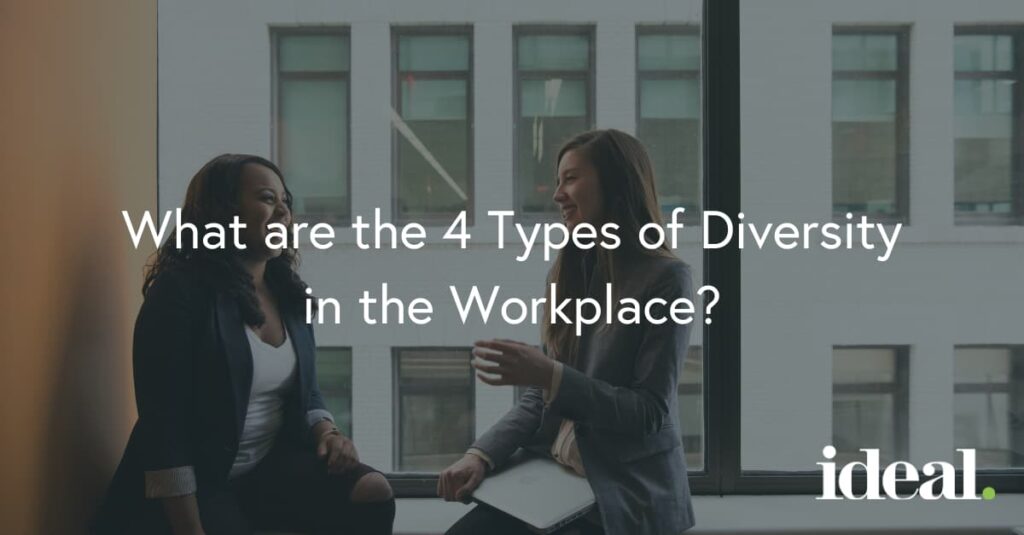
Many HR leaders and executives are on board with new policies and initiatives for increasing diversity in the workplace. Diverse organizations are more adaptable, show consistent revenue growth, and set the standard as competitive industry leaders.
Diversity in the workplace refers to a workforce comprised of individuals of race, ethnicity, gender, age, religion, physical ability, and other demographics.
When considering your diversity goals, it’s important to break down specifically what diversity, equity, and inclusion gaps you have in your workforce. Measuring your organization’s unique demographics is an objective way of tracking your DEI growth and success.
Workplace diversity can be classified into 4 major types – internal, external, organizational, and world view. Read on to see a full breakdown of each type of diversity.
Why diversity matters
There’s a strong business case for workplace diversity. People are the powerhouse behind your business and hiring a variety of demographics positively affects your work environment, revenue, and brand reputation. Executive leaders understand the diversity is key to your organizational success as well as staying competitive in ever-changing markets.
Better employee performance
A workplace study from Deloitte found that employee engagement was higher at organizations embracing diversity and inclusion. When employees feel included, they are more engaged, produce greater quality work, and stay longer with that company.
More innovation
Hiring people from diverse backgrounds brings a variety of new perspectives to the table. Different personal experiences benefit decision-making and problem solving, leading to more creative and productive teams.
Higher revenue
One of the top long-term values is that diverse workforces perform better financially. Numerous studies have shown companies with diverse leadership teams have 19% higher revenue and capturing larger market shares. Company diversity also matters in terms of a positive brand reputation that matches customer values.
Larger talent pool
Cast a wider net for talent. Find the best candidates for your job openings by reducing unconscious bias in the recruitment process. Recruiters can create a blind system of reviewing resumes while keeping a clear eye on their organization’s unique demographics and diversity goals.

4 different types of diversity
Internal diversity
Internal diversity is related to what a person is born into. These demographics are something a person is born with, and are a part of one’s inner concept of self.
Examples of internal diversity include race, ethnicity, age, nation of origin, gender identity, sexual orientation, or physical ability.
While these are personal factors, they tie directly to the 30 rights in the Universal Declaration of Human Rights. An employee should not be subject to any workplace discrimination or unconscious bias related to these personal statuses.
A great example of how Mastercard fosters internal diversity and inclusion is with their Business Resource Groups. These groups are self-governed and based on interests including Asian Culture, African Descent, LGBTQ employees, Women’s Leadership, and Active and veteran military personnel.
Over half of Mastercard’s employees choose to be a part of a Business Resource Group and invest their time into cultivating an inclusive culture with a sense of belonging.
External diversity
External diversity types are characteristics a person is heavily influenced by. These are demographics that a person has the option to change through external action.
Examples of external diversity include education, personal experiences, socioeconomic status, spirituality, religion, citizenship, geographic location, or family status.
It’s important to note that while these external diversity types have the ability to be changed, often they can be difficult to change due to economic or political systems put in place.
An example of how companies can foster diversity in the workplace is by honoring different cultural needs. Kaiser Permente is the largest managed health care organization in the USA, with a permanent workforce with no racial majority. Their diversity agenda fosters external diversity by providing culturally acceptable medical care and appropriate services to all of their employees. There are 140 cultures represented in the United States, all with different needs.
Organizational diversity
Diversity and a diverse work environment positively impact the entire organization. These factors belong to the work we do or the organizations where we work.
Examples of organizational diversity include job function, management status, seniority, department, or union affiliation.
Organizational diversity is important to track, due to its impact on companies. Every level of the organization requires diversity to improve overall DEI within an organization. This means every job function and department is staffed with a variety of people from different demographics.
A real-world example is L’Oréal, who leads for gender equality with women accounting for 53% of key leadership positions, as well as 69% of their workforce. L’Oréal has a strong commitment to organizational diversity by advocating and promoting people from a variety of demographic backgrounds. This global organization has grown its presence to 130 countries and is a leader in their industry.
World view diversity
Each of our world views is different and shaped by our past experiences. Events in our life affect our worldview diversity on a day-to-day basis.
Examples of world view diversity can come from cultural events, political beliefs, knowledge of history, and one’s outlook on life.
As organizations increase their workplace diversity, they may find many employees will have different world views and experiences that may not feel relatable to their peers.
How are organizations like Marriott International Hotels & Resort fostering their world view diversity? With over 174,000+ employees worldwide, Marriott has a dedicated multicultural affairs group that provides cultural education opportunities through forums, webinars, and Culture Day sessions. They nurture diversity across the spectrum, from employing students from disadvantaged communities to creating global communications plans for a sense of community.
Fostering diversity in the workplace offers no shortage of benefits to your workforce and your organizational growth. Request a demo to learn more about our DEI intelligence solution, built for enterprise organizations.
